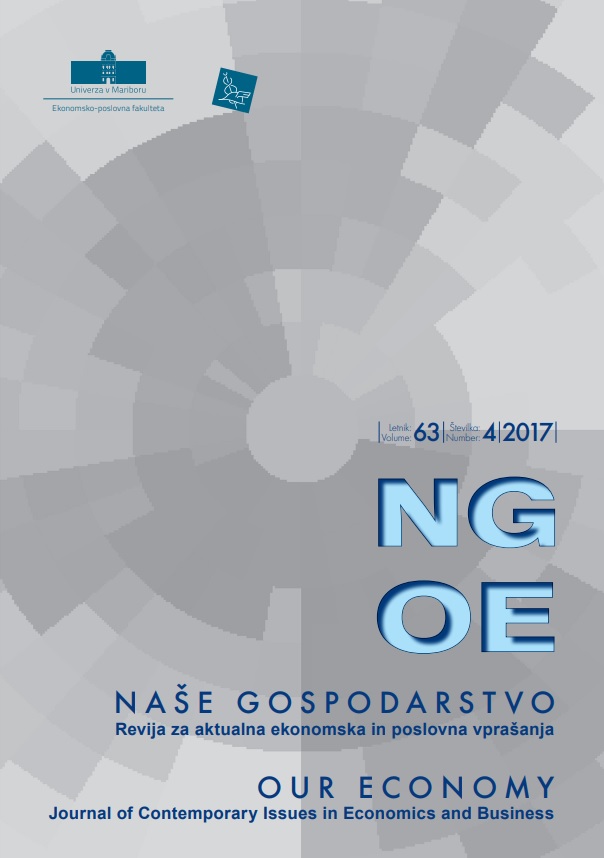Audits as a Vaccine or Just Aspirin?
Keywords:
audits, value added tax, voluntary tax complianceAbstract
This paper examines the impact of audits on voluntary tax compliance in the area of value added tax in Slovenia. The analyses argues that audited taxpayers with additional tax assessments as the result of an audit display a higher level of tax compliance within the year of the audit as within the year before audit, while audited taxpayers with no irregularities on the basis of an audit do not change their behavior significantly within the same period. However, regarding the long- term effect, the results reveal the possibility of worsening tax compliance with respect to audits where an additional tax assessment was imposed and where no irregularities were discovered during an audit.
Downloads
References
Advani, A., Elming, W., Shaw, J. (2015). How long-lasting are the effects of audits? Tax Administration Research Centre, Discussion Paper: 011-15, HM Revenue & Customs.
Agostini, C. A. & Martinez, C. (2014). Response of Tax Credit Claims to Tax Enforcement: Evidence from a Quasi-Experiment in Chile. Fiscal Studies 35(1), 41-65. https://doi.org/10.1111/j.1475-5890.2014.12022.x
Aizenman, J. & Jinjarak, Y. (2008). The collection efficiency of the Value Added Tax: Theory and international evidence. Journal of International Trade and Development 17(3), 391-410. https://doi.org/10.1080/09638190802137059
Ali, M.M., Cecil, W.H., Knoblett, J.A. (2001). The effects of tax rates and enforcement policies on taxpayer compliance: A study of self-em- ployed taxpayers. Atlantic economic journal 29(2), 186-202. https://doi.org/10.1007/BF02299137
Allingham, M.G. & Sandmo, A. (1972). Income tax evasion: A theoretical analysis. Journal of Public Economics 1, 323-338. https://doi.org/10.1016/0047-2727(72)90010-2
Alm, J., Jackson, B.R., Mckee, M. (1992). Estimating the determinants of Taxpayer compliance with experimental data. National Tax Journal 45(1), 107-114.
Alm, J., Sanchez, I., De Juan, A. (1995). Economic and Noneconomic Factors in Tax Compliance. Kyklos 48(1), 3-18. https://doi.org/10.1111/j.1467-6435.1995.tb02312.x
Bergman, M. & Nevarez, A. (2006). Do Audits Enhance Compliance? An Empirical Assessment of VAT Enforcement. National Tax Journal 59(4), 817-832. https://doi.org/10.17310/ntj.2006.4.04
Cardillo, G. (2006). Dunn's Test: a procedure for multiple, not parametric, comparisons. Retrieved from http://www.mathworks.com/matlabcentral/fileexchange/12827
Cardillo, G. (2009). KWTEST, Kruskal-Wallis non parametric test for Analysis Of Variance. Retrieved from http://www.mathworks.com/matlabcentral/fileexchange/25860
Cardillo, G. (2011). WINSORISING: Winsorising Data. Retrieved from http://www.mathworks.com/matlabcentral/fileexchange/
CASE - Centre for Social and Economic Research - Netherlands Bureau for Economic Policy and Analysis (2013). Study to quantify and analyse the VAT Gap in the EU-27 Member States. Retrieved from http://ec.europa.eu/taxation_customs/resources/documents/common/publications/studies/vat-gap.pdf
Dubin, A. J. & Wilde, L. L. (1988). An Empirical Analysis of Federal Income Tax Auditing and Compliance. National Tax Journal 41(1), 61-74. Gemmell, N. & Ratto, M. (2012). Behavioral responses to taxpayer audits: Evidence from random taxpayer enquiries. National Tax Journal 65(1), 33-58. https://doi.org/10.17310/ntj.2012.1.02
Hauptman, l., Horvat, M., Korez-Vide, R. (2014). Improving Tax Administration's Services as a Factor of Tax Compliance: The Case of Tax Audit. Lex Localis – Journal of local self-government 12(3), 481-501.
Hoopes, J.L., Mescall, D., Pittman, J.A. (2012). Do IRS audits deter corporate tax avoidance? The accounting review 87(5), 1603-1639. https://doi.org/10.2308/accr-50187
IMF (2009). Collecting Taxes during an Economic Crisis: Challenges and Policy Options. IMF Staff Position Note. Retrieved from: http://www.imf.org/external/index.htm
Kamdar, N., (1997). Corporate income tax compliance: A time series analysis. Atlantic economic journal 25(1), 37-49. https://doi.org/10.1007/BF02298475
Kleven, H. J., Knudsen, M. B., Kreiner, C. T., Pedersen, S., Saez, E. (2011). Unwilling or unable to cheat? Evidence from a tax audit experiment in Denmark. Econometrica 79(3), 651-692. https://doi.org/10.3982/ECTA9113
Lešnik, T., Kračun, D., Jagrič, T. (2014a). Recession and Tax Compliance – The Case of Slovenia. Inzinerine Ekonomika – Engineering Economics 25(2),130-140.
Lešnik, T., Kračun, D., Jagrič, T. (2014b). Tax Compliance and Corporate Income Tax – The Case of Slovenia. Lex Localis – Journal of local self-government 12(4), 793-811.
Matthews, K. (2003). VAT Evasion and VAT Avoidance: Is there a European Laffer Curve for VAT? International Review for Applied Economics 17(1), 105-114. https://doi.org/10.1080/713673162
OECD (2008). Monitoring Taxpayer's Compliance: A practical Guide Based on Revenue Body Experience. Forum on Tax Administration: Compliance Sub-group. Retrieved from: http://www.oecd.org/tax/taxadministration/40947920.pdf
OECD (2010). Understanding and Influencing Taxpayers' Compliance Behavior. Forum on Tax Administration: Small / Medium Enterprise (SME) Compliance Subgroup. Retrieved from: http://www.oecd.org/tax/administration/46274793.pdf
Palil, M. R. & Mustapha, A. F. (2011). Factors affecting tax compliance behavior in self-assessment system. African Journal of Business Management 5(33), 12864-12872.
Plumley, A. H. (2002). The Impact of the IRS on Voluntary Tax Compliance: Preliminary Empirical Results. National Tax Association, 95th Annual Conference of Taxation. Retrieved from http://www.irs.gov/pub/irs-soi/irsvtc.pdf
Reckon. (2009). Study to quantify and analyze the VAT gap in the EU-25 Member States. Retrieved from http://ec.europa.eu/taxation_customs/resources/documents/taxation/tax_cooperation/combating_tax_fraud/reckon_report_sep2009.pdf
OECD. (2014). Consumption tax trends 2014. OECD Publishing. Retrieved from http://www.keepeek.com/Digital-Asset-Management/oecd/taxation/consumption-tax-trends-2014_ctt-2014-en#page92 https://doi.org/10.1787/ctt-2014-en
